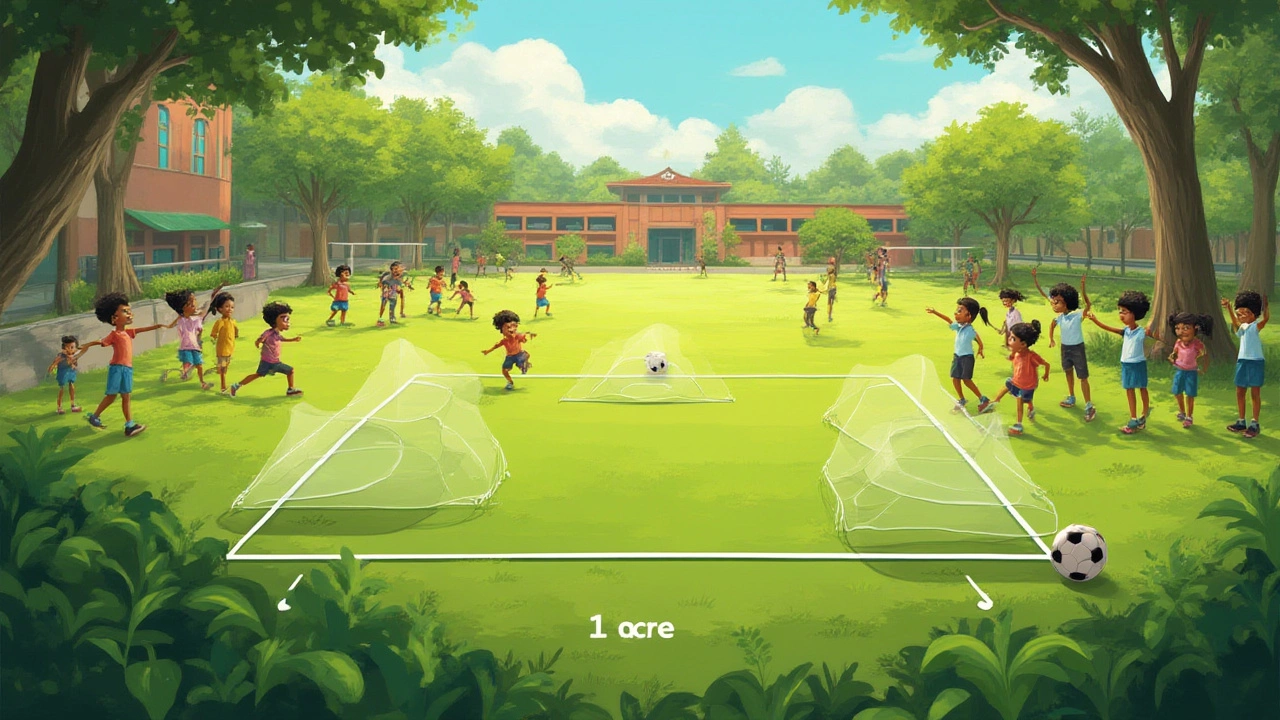Picture this: you’re standing in an open field, someone points at the land and asks, “How many football fields fit into an acre?” It’s one of those everyday riddles that pops up in backyard conversations, during home searches, and when you’re sizing up that plot of land you saw on Zillow. Most folks have walked across a football field or at least watched a game on TV, but an acre? It can still feel mysterious—even in 2025 when we can measure everything with just a tap. The truth is, the answer isn’t as straight-up as people think, but once you get familiar with some weird yet relatable comparisons, you won’t forget it. Let’s break it all down so next time the question comes up, you’ll sound like the sharpest tool in the shed (or at least the most accurate one at the barbecue).
What Exactly Is an Acre?
If you’ve ever checked out a land listing and seen “1 acre” but had no clue what that really means, you’re not alone. An acre is a standard unit for measuring land area, mostly used in the US and UK. The history’s a bit wild—hundreds of years ago in England, an acre was basically the amount of land one man could plow with an ox in a day. Sounds like something out of a medieval movie, but now it's locked in as exactly 43,560 square feet. Try picturing that? It’s tough. That’s why people love comparing it to football fields.
But here’s the kicker: not every football field on Earth is the same size. In the US, when someone says “football field,” they usually mean American football. That classic field you see on Sundays measures 360 feet long and 160 feet wide. Multiply those two numbers, and you get 57,600 square feet—including the end zones. Sometimes, people drop the end zones—then it's a 300-by-160-foot rectangle. But let’s stick to the full field because, let’s be real, the touchdowns are part of the fun.
So, just to be crystal clear, here are the standard sizes in a handy chart:
| Type | Length (ft) | Width (ft) | Area (sq ft) |
|---|---|---|---|
| American Football Field (with end zones) | 360 | 160 | 57,600 |
| American Football Field (no end zones) | 300 | 160 | 48,000 |
| Standard Acre | - | - | 43,560 |
| FIFA Soccer Field (average) | 345 | 223 | 76,935 |
So an acre isn’t even big enough to cover one whole football field. Wild, right? Just by numbers, a single standard football field is about 1.32 acres. Flip that around? One acre is about 0.76 (or about 3/4) of an American football field. Suddenly, “an acre of land” sounds a bit cozier—unless you’re lining up as a defensive tackle, then it’ll still feel massive.
Comparing Acres to Football Fields: Visualizing the Size
Trying to picture acres in terms of football fields makes a lot of sense—almost everyone’s walked sideline to sideline, even if only during gym class. So let’s put these numbers into something real. If you cut a football field (with end zones included) into four almost-equal stripes across its width, each strip would be just a bit less than an acre. Lay the strips out side by side, and the first three add up to more than two acres. So, if you want to “google map” an acre in your mind, think about starting at one end zone and running all the way down to 75 percent of the way to the other end. That’s your acre.
The funny thing is, TV often tricks us. On-screen, those fields look like endless plains. But drive past your local school’s football field or look down from the bleachers—a full-size, green rectangle feels smaller once you realize that a whole acre is less than a field. Want a quick trick? A full acre is about 208.7 feet by 208.7 feet if it was a perfect square. So, an acre doesn’t quite cover the whole playing area but gets really close if you lop off a little from the length.
Now, let’s make it even wackier. The U.S. White House lawn? Around 18 acres. Central Park, New York? A “tiny” 843 acres. If you tried to pack football fields into one acre, you could fit about 0.76 of them—so about three-quarters of a field. Or, you can squeeze in about 15 tennis courts, if you ever win the lottery and decide to get creative.

Why Acres and Football Field Comparisons Matter
You might wonder, aside from random trivia, why bother learning this? Turns out, comparing acres to football fields solves real-life puzzles. Shopping for land? Numbers like “43,560 square feet” mean nothing if you’ve never seen that many square feet at once. Jobs like real estate agents and developers toss around these figures all the time, so people love this shortcut. If someone says, “I have a backyard half an acre in size,” you can instantly know it’s just a little bit smaller than half a football field. Not bad for picturing whether a dream pool will fit—or maybe you’re thinking of starting that backyard soccer league.
This trick is useful for all sorts of stuff outside of real estate. Ever tried planning an outdoor wedding, a community picnic, or wondered if your neighborhood park could fit a full-size football field? If you know an acre is just under 3/4 the size of a field, you’ve got your answer. Even farmers and gardeners use this to figure out if they’ve got space for enough crops or fruit trees. Construction crews also measure progress in acres—the more you can think in relatable real-world units, the less you’ll get lost in math that feels abstract.
There’s also something just plain satisfying about bringing big measurements down to earth. Land measurements go way back, but we still grab onto comparisons that feel familiar—no one’s ever said, “That field is a solid 43,560-square-foot vibe.” It’s always, “That’s about three-quarters of a football field.” When you start thinking in football fields, you suddenly find it easier to make decisions, plan projects, and maybe even dream a little bigger.
Tips and Tricks for Visualizing Land Area
Still struggling to picture an acre? Here are some tips to make it stick:
- Find a local football field and walk from one goal line toward the other—stop about 24 yards before the end. That’s roughly an acre.
- If you prefer squares, imagine a space that’s 208.7 feet on each side. That’s nearly two-thirds the size of a full field running lengthwise and widthwise.
- Picture a standard, single-family house lot in the U.S.—most are only about a fifth of an acre. So five house lots? You’re in acre territory.
- For crowd-counter types: a solid acre can hold about 350 parked cars, if each takes up a regular spot. Planning a big event? This can save some headaches—and arguments.
- If you’re more into gardening, an acre can support about 400 apple trees if they’re spaced six feet apart. Good news for aspiring cider makers.
- Trying to impress friends? Drop the fact that Disneyland is about 500 acres. That’s around 380 football fields, stacked end to end. Wild, right?
Here’s a funny thought: if you ever read about UFO sightings (“The UFO was the size of three football fields!”), now you’ve got the conversion in your back pocket. Just multiply by 1.32, and you’ll know exactly how many acres those aliens were supposedly flying over.
If you want to sound like an English major at the dinner table, you can explain that the acre actually comes from old English words meaning “open field.” Today, it’s just a handy way to make acres make sense in your own backyard.
Ready for a bonus tidbit? The average golf course is more than 100 acres. You’d need over 75 football fields to cover all that green. Now, next time you see a massive sports complex or a farm for sale, you can break out your own football field math.

